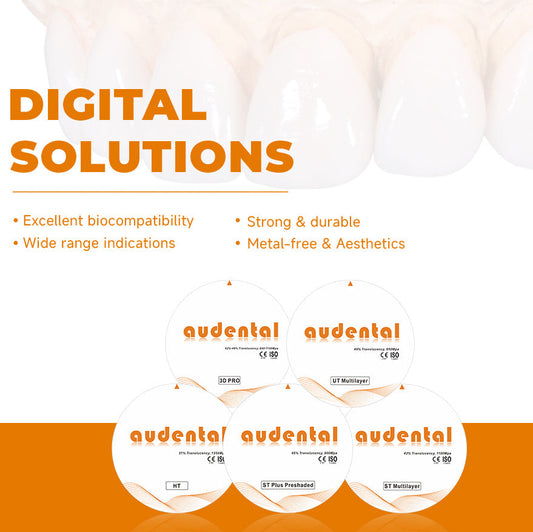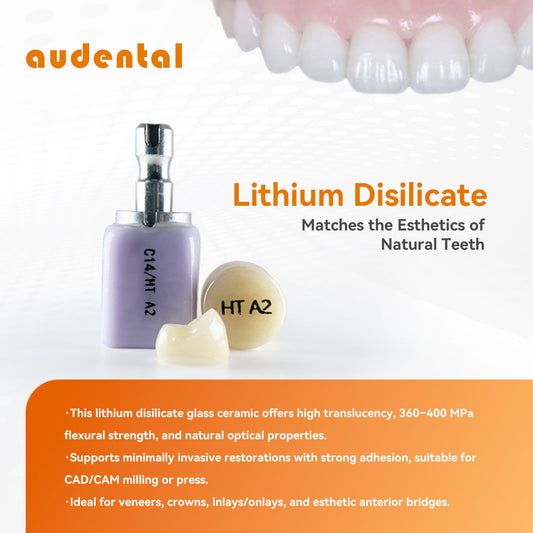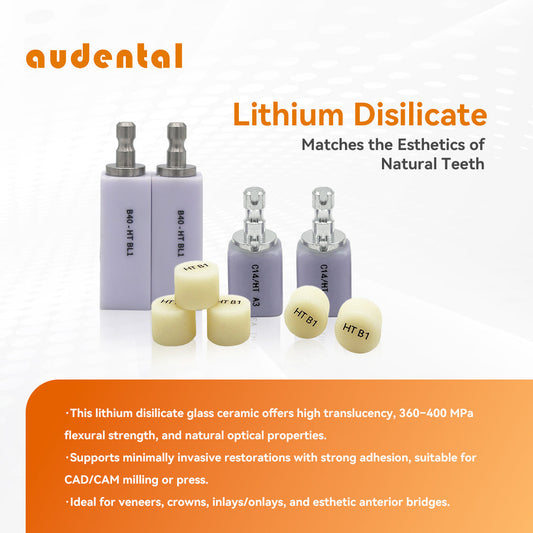Application of Dental Zirconia Blocks
Share
Dental zirconia blocks (Zirconia Blocks) have become one of the most important materials in modern dental restoration due to their exceptional strength, aesthetic qualities, and biocompatibility. Their wide range of applications has made them a crucial part of the dental restoration field, particularly in crowns, bridges, implant restorations, and full arch restorations. The following is a detailed explanation of the main applications of dental zirconia blocks.


3d pro zirconia block and its indications
1. Crown Restoration
One of the most common applications of zirconia blocks is the production of crowns, especially full-ceramic crowns. The excellent mechanical properties of zirconia allow it to perform exceptionally well under the chewing forces present in the oral cavity. Compared to traditional metal-ceramic crowns, zirconia crowns offer not only higher flexural strength but also better aesthetic results.
Aesthetic Advantages: Zirconia has a translucency similar to that of natural teeth, enabling it to better mimic the color and shine of natural teeth. This makes it particularly suitable for anterior restorations. By using high-transparency zirconia materials, a highly natural appearance can be achieved, allowing the crown to blend seamlessly with surrounding teeth.
Strength Advantages: The compressive strength of zirconia crowns typically exceeds 1000 MPa, making them ideal for posterior restorations. Zirconia's hardness also gives it excellent wear resistance, allowing the restoration to maintain its integrity over time, especially under heavy chewing forces, thus preventing excessive wear.


3d pro zirconia block crown restoration
2. Bridge Restoration
Zirconia blocks are also widely used in bridge restorations, particularly when multiple teeth or large-span bridges need to be restored. Due to the strength and stability of zirconia, it can provide adequate support and ensure the durability of the restoration over time.
Long-span and Multi-unit Bridges: Zirconia materials have significant advantages in producing multi-unit bridges and long-span bridges. Its high strength and excellent compressive resistance allow long-span bridges to withstand greater chewing forces. Additionally, the toughness of zirconia helps prevent breakage or cracking in bridge structures.
Aesthetic Requirements: In bridge applications, zirconia is not only valued for its functional qualities but also for its aesthetic appeal. By utilizing layered zirconia technology, the outer layer can be made to have a transparency similar to that of natural teeth, while the inner layer provides strength, achieving a balance between aesthetics and function.



3d pro zirconia block bridge restoration
3. Implant Restoration
Due to its superior biocompatibility and corrosion resistance, zirconia has become an indispensable material in modern implant restoration, particularly in the fabrication of implant crowns, providing patients with a more comfortable, safe, and natural restoration outcome.
Biocompatibility: The biocompatibility of zirconia is a significant advantage in implant restoration. The material is highly compatible with oral tissues, effectively reducing inflammation or rejection reactions and ensuring the long-term stability of the implant restoration.
Excellent Mechanical Properties: Zirconia not only withstands substantial chewing forces but also resists stress concentrations during the implant restoration process, preventing damage to the restoration caused by uneven load distribution.
Metal-free Advantage: One of the key benefits of zirconia in implant restoration is that it is entirely metal-free, meaning there is no risk of metal allergies or oral metal reactions. For patients sensitive to metals, zirconia is the ideal choice.
4. Full Arch Restoration
Full arch restoration refers to the reconstruction of all or part of the teeth for patients with complete or partial tooth loss. Zirconia is widely used in full arch restoration, particularly for patients who require the rebuilding of an entire upper or lower jaw of teeth. The high strength and aesthetic properties of zirconia make it an ideal material for this application.
Full Denture Restoration: In full arch restoration, zirconia is commonly used to fabricate fixed bridges or removable dentures. Its high strength and excellent bending performance ensure that even large-area restorations maintain long-term stability.
Enhanced Chewing Function: For patients suffering from difficulty chewing due to tooth loss, zirconia restorations can significantly improve chewing function. Its hardness and strength allow the restoration to bear greater chewing forces, thus restoring the patient's normal eating abilities.
Aesthetic Effects: For full arch restoration, zirconia not only provides sturdy support but also restores the patient's original tooth appearance through high translucency and natural color. This is particularly evident in anterior restorations, where zirconia excels.


5. Restoration Liner Materials
In some complex restorative designs, zirconia is also used as a liner material in other restorations to enhance their strength and stability. For example, when fabricating partial restorations with metal frameworks, zirconia can serve as a liner, providing stronger support for the outer ceramic or other materials.
Enhancing Restoration Stability: The hardness and crack resistance of zirconia make it an ideal liner material. It significantly enhances the bending strength of the restoration and helps to distribute chewing forces in the mouth, thereby prolonging the service life of the restoration.
Conclusion
Dental zirconia blocks, with their exceptional mechanical properties, biocompatibility, wear resistance, and aesthetic qualities, play a pivotal role in modern dental restorations. From crowns to bridges, from implant restorations to full arch restorations, zirconia provides patients with safer, more comfortable, and aesthetically pleasing restorative solutions. As technology advances, the precision of zirconia material processing and color matching continues to improve, and its application in dental restorations is expected to expand even further.



